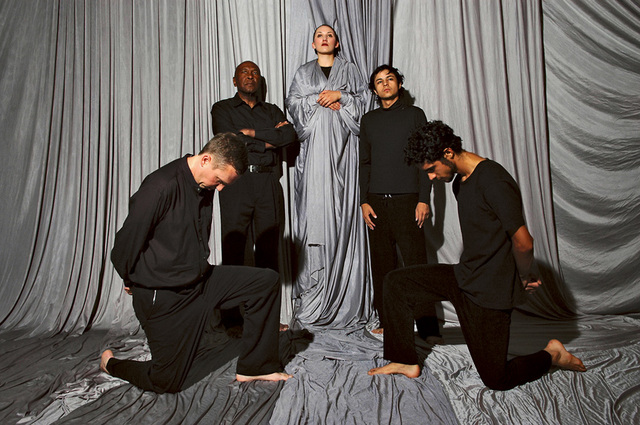The exact number is unclear. It could be as few as 40,000 or upward of 800,000, depending on the history book you read. But other details are solid: In 1492, the same year Christopher Columbus set sail for the New World, thousands of Spanish Jews left Spain. Not to explore but to flee persecution and death at the hands of the Spanish Inquisition.But the Inquisition followed them, forcing many Jews into hiding—some right here in New Mexico. In many families, the Jewish ancestry was kept so secret, later generations never knew of their religious heritage. Some still don’t.When Richard McClarkin moved to New Mexico more than 10 years ago, he didn’t know much about the Sephardim, Jews of the Spanish rite. “When I was in high school [in Detroit], we did a couple of days on the Inquisition,” he says. “But our emphasis tended to be more on the British movement into the Americas and not a lot on how the Spanish got here.” For the past year, McClarkin has learned a great deal about the history of the conversos, also called New Catholics, and Crypto-Jews, those who converted to Catholicism publicly but practiced Judaism in secret, as a cast member of the Working Classroom’s original production A Light In My Soul/Una Luz En Mi Alma .In the play, McClarkin portrays Father Espinosa, a converso whose family fled Spain and converted to Catholicism and stopped practing Judaism to avoid the Inquisition. Though his name has been changed, Father Espinosa is a real person, one of the many who agreed to be interviewed by Working Classroom theater ensemble members for the creation of A Light In My Soul. The seed of this project was planted after the successful 2005 production of Highway 47 , a play by K.J. Sanchez about the land grant struggle in Tomé. “The response was overwhelming,” says Working Classroom’s Executive Director Nan Elsasser. “After that, it was clear that New Mexicans really hunger for theater that’s really about New Mexico.”Elsasser says the company, which is made up of actors ages 11 to 65, has since committed itself to creating historical pieces rooted in our state. Elsasser found the subject of the conversos and Crypto-Jews fitting as it speaks to Jewish and Hispanic New Mexicans as well as those interested in stories of struggle and oppression. “It is theater waiting to be put on stage,” she says. “This is virgin territory.”Originally, the company thought to do a work of fiction, Elsasser says. But after talking with Moisés Kaufman of the Tectonic Theater Project in New York City, with whom Working Classroom has a 20 year history, the company took another direction. Tectonic is known for putting current events and questions of history on the stage, as it did with the critically acclaimed Laramie Project, which was later adapted by HBO and nominated for four Emmy awards. Kaufman suggested to Elsasser that she take a similar approach with A Light In My Soul and use interviews with conversos and Crypto-Jews as the performance’s base material. Elsasser and her ensemble did just that, and with the help of Leigh Fondakowski of Tectonic and director/choreographer Krista DeNio, Working Classroom’s original play will make its world debut at the National Hispanic Cultural Center on Aug. 15.Over the past year, Fondakowski and DeNio worked with the ensemble to create A Light In My Soul out of the interviews they collected using a method called Moment Work. The idea, DeNio says, is to take the material from the interviews and let the actor use theatrical elements such as movement, lighting or props to highlight a moment that stands out. After weeks of workshops and observing the actors as they explored the interviews, Fondakowski pulled together the created moments, or scenes, into one cohesive story. This became the script of A Light In My Soul . “It’s a very unique process; it’s not the way a lot of theater gets made in America,” she says. “It’s a conversation between the content and the theatrical form.” The final product is nearly all verbatim transcripts from the interviews, DeNio says, although there is one fictionalized scene that depicts King Ferdinand and Queen Isabella as they give the Alhambra Decree, telling Jews to convert or get out.During the entire process—through interviewing, workshops, scripting and staging—the conversos and Crypto-Jews whose stories are being told have been included. When Working Classroom ensemble members approached the interviewees, the members were clear to indicate they intended to tell the conversos ‘ and Crypto-Jews’ stories without interpretation, Elsasser says. In keeping with that, the interviewees were invited to view the progress of the piece during construction and rehearsal to ensure they were comfortable with the use of their families’stories, she says. Cast members met with the people they are portraying in casual, non-interview settings after the script was set to help them connect even more with the person whose life makes up a portion of A Light In My Soul. McClarkin has met with Father Espinosa many times. “Initially, I was sort of confused—I didn’t know how pull this together. Still I’m not sure I know how to pull this together,” he says. “It’s a daunting task to say that you want to portray something like this. What we are talking about are experiences of families over generations.”
Working Classroom presents A Light In My Soul/Una Luz En Mi Alma at the National Hispanic Cultural Center (1701 Fourth Street SW, 724-4771) on Friday and Saturday, Aug. 15 and 16, at 8 p.m. and Sunday, Aug. 17, at 2 p.m. Tickets are $20 general, $12 students and seniors. For more info, visit workingclassroom.org.










